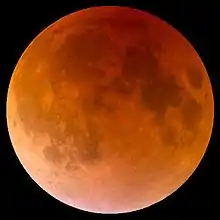March 1988 lunar eclipse
A penumbral lunar eclipse took place on March 3, 1988, the first of two lunar eclipses in 1988.[1] Earlier sources compute this as a 0.3% partial eclipse lasting under 14 minutes, and newest calculations list it as a penumbral eclipse that never enters the umbral shadow.[2]
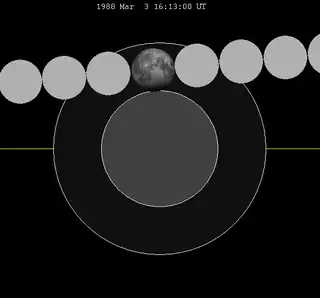
This was a relatively rare total penumbral lunar eclipse with the moon passing entirely within the penumbral shadow without entering the darker umbral shadow.
The tables below contain detailed predictions and additional information on the Penumbral Lunar Eclipse of 3 March 1988.
Penumbral Magnitude: 1.09076
Umbral Magnitude: -0.00163
Gamma: 0.98855
Saros Series: 113th (62 of 71)
Date: 3 March 1988
Greatest Eclipse: 03 Mar 1988 16:12:45.7 UTC (16:13:41.5 TD)
Ecliptic Opposition: 03 Mar 1988 16:01:03.9 UTC (16:01:59.8 TD)
Equatorial Opposition: 03 Mar 1988 15:09:41.3 UTC (15:10:37.2 TD)
| Coordinate | Sun | Moon |
|---|---|---|
| Right Ascension | 22.97 | 11 |
| Declination | -6.6 | 7.3 |
| Diameter (arcseconds) | 1935.6 | 1772.0 |
| Equatorial Horizontal Parallax (arcseconds) | 8.9 | 3251.6 |
Visibility
The total penumbral lunar eclipse was visible over Europe, Africa, Asia, Australia, northwestern North America, seen rising over the 30th meridian east and setting over the 150th meridian west on the Equator.
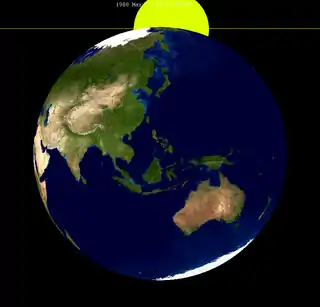
Relations to other lunar eclipses
Eclipses of 1988
Saros series
This eclipse is part of Saros cycle series 113.
Lunar year series
| Lunar eclipse series sets from 1988–1991 | ||||||||
|---|---|---|---|---|---|---|---|---|
| Descending node | Ascending node | |||||||
| Saros | Date | Type Viewing |
Gamma | Saros | Date Viewing |
Type Chart |
Gamma | |
| 113 | 1988 Mar 03 |
Penumbral |
0.98855 | 118 | 1988 Aug 27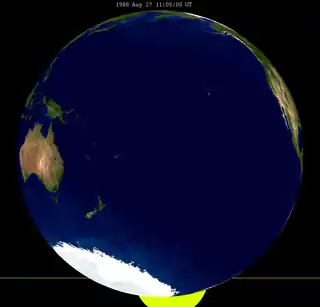 |
Partial |
-0.86816 | |
| 123 | 1989 Feb 20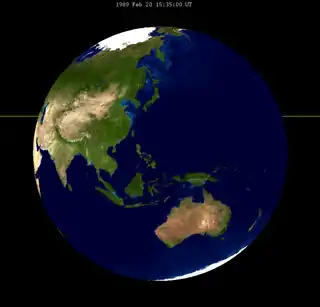 |
Total 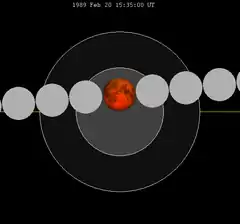 |
0.29347 | 128 | 1989 Aug 17 |
Total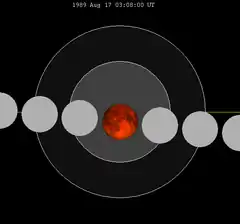 |
-0.14905 | |
| 133 | 1990 Feb 09 |
Total |
-0.41481 | 138 | 1990 Aug 06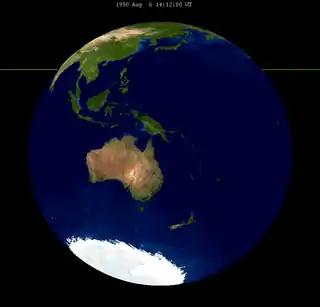 |
Partial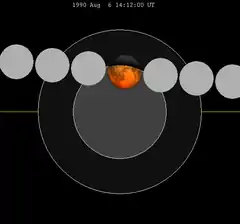 |
0.63741 | |
| 143 | 1991 Jan 30 |
Penumbral |
-1.07522 | 148 | 1991 Jul 26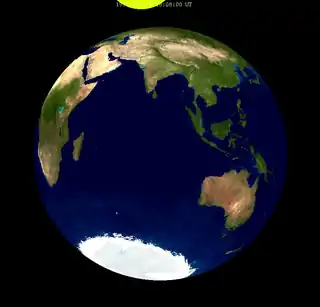 |
Penumbral |
1.43698 | |
| Last set | 1987 Apr 14 | Last set | 1987 Oct 07 | |||||
| Next set | 1991 Dec 21 | Next set | 1991 Jun 27 | |||||
Metonic series
The Metonic cycle repeats nearly exactly every 19 years and represents a Saros cycle plus one lunar year. Because it occurs on the same calendar date, the earth's shadow will be in nearly the same location relative to the background stars.
|
|
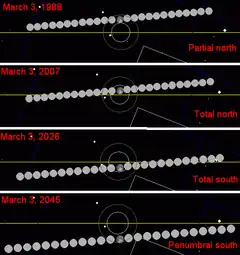 |
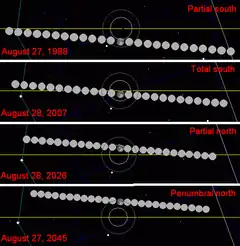 |
Half-Saros cycle
A lunar eclipse will be preceded and followed by solar eclipses by 9 years and 5.5 days (a half saros).[3] This lunar eclipse is related to two total solar eclipses of Solar Saros 120.
| February 26, 1979 | March 9, 1997 |
|---|---|
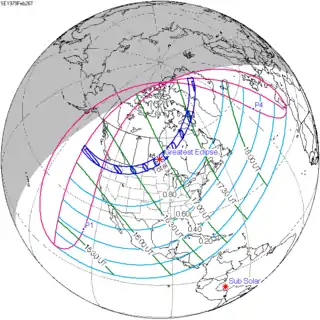 |
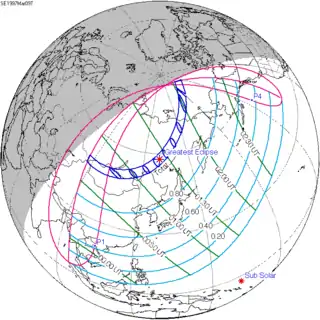 |
See also
- List of lunar eclipses
- List of 20th-century lunar eclipses
Notes
- Hermit Eclipse: Saros cycle 113
- Total Penumbral Lunar Eclipses, Jean Meeus, June 1980
- Mathematical Astronomy Morsels, Jean Meeus, p.110, Chapter 18, The half-saros

